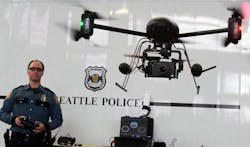IACP Seeks to Sway Public on Unmanned Aircraft
Later this year, some state legislatures and Congress could consider bills that would limit the use of unmanned aircraft by law enforcement.
Baltimore County, Md., Police Capt. Don Roby, Chairman of the International Association of Chiefs of Police's aviation committee, told Officer.com that departments must enlist the help of their communities to help quell some of the privacy concerns that have led to much of the public backlash.
"People think the government is going to be following them around in these quiet, stealthy, unmanned aircraft," he said. "As law enforcement -- as public servants -- we have to reassure the public that that's not going to happen."
The IACP has been referring to the devices as "small unmanned aircraft systems," instead of the more commonly used "drones," which Roby said makes it sound like departments are planning to deploy armed predator drones -- like the ones used by the military.
"That somewhat feeds into the fear of individuals that this is a sustainable device in which people are out there with this type of aircraft to fly it 24 hours or 48 and that it is a persistent surveillance platform."
A majority of the devices, according to Roby, have a very short duration for flight and are battery-operated.
The deployment of unmanned aircraft is very much officer safety-driven, he said, and can be used for tactical or SWAT operations, small-scale search and rescues and crime scene photography.
"The IACP looks at this as a valuable tool for law enforcement and as an officer safety tool," he said. "We definitely endorse these devices. Of course, we endorse them with the proper use, and that is why we became involved in this issue."
Last year, the group released guidelines for the use of small unmanned aircraft systems.
Read: Unmanned Aircraft Guidelines
The document includes recommendations for areas including system requirements, operational procedures and image retention.
The IACP also took concerns from the ACLU and integrated them into the guidelines.
Engaging the Community
Roby said that every law enforcement agency should engage with its community from the start, even before it decides to purchase an unmanned aircraft system.
"Make it a very transparent process and make sure the community is involved in the selection of the device to be used," he said.
"(Agencies) can ensure the communities that they are protecting the citizens' constitutional rights from unreasonable search and seizure."
He said that agencies must also allow the community to have a hand in crafting the policies, meet with the media and make sure that everyone is brought in early on in the process.
In some cases where this was not done, Roby said that public outcry has led to departments and municipalities being forced to rethink the use of unmanned aircraft altogether.
In February, Seattle Mayor Mike McGinn ordered the police department to abandon its unmanned aerial vehicle program after residents and privacy advocates protested.
"There have been agencies that have had to postpone or just outright cancel any plan to fly them," he said. "Their communities didn't want them flying them. This is why you have to get everyone involved."
Requirements and Procedures
The IACP guidelines list a number of recommended system requirements and operational procedures for departments using unmanned aircraft.
The group recommends agencies make sure they have a device that captures flight times, that the device has very high visibility with a paint scheme on it so people can see the device when it's in the air and that they are making sure that the aircraft is not equipped with any type of weapons -- including less-lethal force weapons.
Roby said that it is also important that agencies should always use professional-grade aircraft.
"We want to make sure they are not using model aircraft," he said, noting that the device should be professionally designed with safety features. "We don't want them just sticking a camera on a radio-controlled aircraft."
Departments are expected to adhere to all of the FAA rules, obtain a certificate of authentication, allow the aircraft to be operated only by trained personnel, have an approval process in place for flights and to ensure flights are being properly tracked.
Roby said that there also must be a policy addressing image retention including how long images are kept and who has access to them.
Taking Flight
While the technology is currently available and more companies have began manufacturing the devices, Roby said departments may have to wait to take to the skies.
"I think it's going to be a long drawn out process," he said, adding that about 30 states have introduced legislation dealing with unmanned aircraft systems along with legislation being considered by Congress.
The IACP has continued to work with its state chiefs associations to get the word out about the importance of the devices and has also worked with other associations such as the Airbourne Law Enforcement Association and the National Sheriffs Association.
"It's an exciting technology and we're kind of stifling this technology, stifling the production of these devices, however, understandably we have to deal with the privacy issue," he said.
"It's going to be a long process to educate people on these devices."
About the Author
Paul Peluso
Editor
Paul Peluso is the Managing Editor of OFFICER Magazine and has been with the Officer Media Group since 2006. He began as an Associate Editor, writing and editing content for Officer.com. Previously, Paul worked as a reporter for several newspapers in the suburbs of Baltimore, MD.

